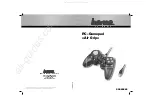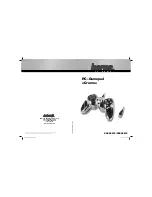
3.
Use the following procedure to reset the
Type VSX8:
a. To properly reset the Type VSX8 slam shut
after it has been tripped to the closed position,
a flat-head screwdriver must be inserted into
the backside of the reset button.
b. The screwdriver should be slowly rotated to
gradually pull the reset button away from the
Type VSX8 device. This slow movement allows
for a slow bleed of the pressure across the
Type VSX8 slam shut’s disk and seat area. The
operator should be able to hear the pressure
bleeding through the system.
c. When the pressure has equalized and the
air bleeding sound has dissipated, the reset
button should be pulled completely away from
the Type VSX8 slam shut device by hand
until the internal shut-off mechanism has
been re-latched.
d.
Once the operator feels the click of the re-latch
occurring, the reset button should be pushed
completely back into its original position.
4. Slowly open the hand valve (if used) in the
control line. The regulator will control downstream
pressure at the pilot control spring setting. See
the Adjustment section following these numbered
steps if changes in the setting are necessary
during the start-up procedure.
5. Slowly open the downstream block valve.
6. Slowly close the bypass valve, if used.
7. Check all connections for leaks.
299H Series adjustment
Keys are referenced in Figure 5. The only adjustment
on a 299H Series regulator is the reduced pressure
setting of the pilot control spring (key 32). Remove
the closing cap (key 29) and turn the adjusting screw
(key 36). Turning the adjusting screw clockwise into
the spring case increases the controlled or reduced
pressure setting. Turning the screw counterclockwise
decreases the reduced pressure setting. Always
tighten the locknut (key 35) and replace the closing
cap after making adjustments.
Shutdown
Installation arrangements may vary, but in any installation
it is important to open and close valves slowly and the
outlet pressure be vented before venting inlet pressure to
prevent damage caused by reverse pressurization of the
regulator. Isolate the regulator from the system. Vent the
downstream pressure; then vent inlet pressure to release
any remaining pressure in the regulator.
Maintenance
Regulator parts are subject to normal wear and must
be inspected periodically and replaced as necessary.
The frequency of inspection and replacement depends
upon the severity of service conditions and upon
applicable codes and government regulations.
Due to the care Emerson takes in meeting all
manufacturing requirements (heat treating,
dimensional tolerances, etc.), use only replacement
parts manufactured or furnished by Emerson.
WaRning
!
avoid personal injury or damage
to property from sudden release
of pressure or uncontrolled gas or
other process fluid. Before starting
to disassemble, carefully release all
pressures according to the Shutdown
procedure. use gauges to monitor inlet,
loading and outlet pressures while
releasing these pressures.
On reassembly of the regulator, it is recommended
that a good quality pipe thread sealant be applied to
pressure connections and fittings and a good quality
lubricant be applied to all O-rings. Also apply an anti-
seize compound to the adjusting screw threads and
other areas as needed.
note
The regulator body may remain in the
pipeline during maintenance procedures.
Main actuator Diaphragm
Follow this procedure to change the actuator
diaphragm or to inspect, clean or replace any other
parts in the main actuator. Part key numbers are
referenced in Figures 3 and 4.
9
299H Series






































